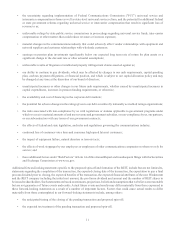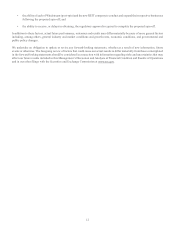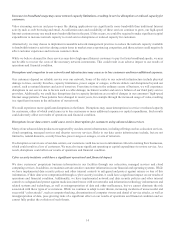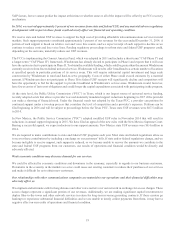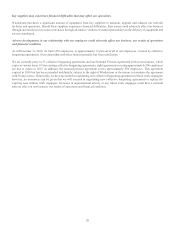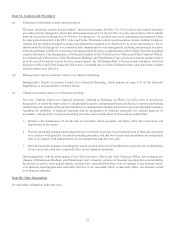Windstream 2014 Annual Report Download - page 91
Download and view the complete annual report
Please find page 91 of the 2014 Windstream annual report below. You can navigate through the pages in the report by either clicking on the pages listed below, or by using the keyword search tool below to find specific information within the annual report.
15
We cannot assure you we will continue paying dividends at the current rate.
Our board of directors maintains a current dividend practice for the payment of quarterly cash dividends at a rate of $0.25 per
share of common stock. This practice can be changed at any time at the discretion of the board of directors, and our common
stockholders should be aware that they have no contractual or other legal right to dividends. In addition, the other risk factors
described in this section could materially reduce the cash available from operations or significantly increase our capital expenditure
requirements, and these outcomes could cause funds not to be available when needed in an amount sufficient to support our current
dividend practice.
The amount of dividends that we may distribute is also limited by restricted payment and leverage covenants in our credit facility
and indentures, and, potentially, the terms of any future indebtedness that we may incur. The amount of dividends that we may
distribute is also subject to restrictions under Delaware law. If our board of directors were to adopt a change in our current dividend
practice that results in a reduction in the amount of dividends, such change could have a material and adverse effect on the market
price of our common stock.
We are subject to various forms of regulation from the Federal Communications Commission (“FCC”) and state regulatory
commissions in the states in which we operate, which limit our pricing flexibility for regulated voice and high-speed Internet
products, subject us to service quality, service reporting and other obligations and expose us to the reduction of revenue from
changes to the universal service fund, the intercarrier compensation system, or access to interconnection with competitors’
facilities.
As of December 31, 2014, we had operating authority from each of the 48 states and the District of Columbia in which we conducted
local service operations, and we are subject to various forms of regulation from the regulatory commissions in each of these areas
as well as from the FCC. State regulatory commissions have jurisdiction over local and intrastate services including, to some
extent, the rates that we charge and service quality standards. The FCC has primary jurisdiction over interstate services including
the rates that we charge other telecommunications companies that use our network and other issues related to interstate service.
In some circumstances, these regulations restrict our ability to adjust rates to reflect market conditions and may affect our ability
to compete and respond to changing industry conditions.
Future revenues, costs, and capital investment in our wireline business could be adversely affected by material changes to or
decisions regarding applicability of government requirements, including, but not limited to, changes in rules governing intercarrier
compensation, state and federal USF support, competition policies, and other pricing and requirements. Federal and state
communications laws and regulations may be amended in the future, and other laws and regulations may affect our business. In
addition, certain laws and regulations applicable to us and our competitors may be, and have been, challenged in the courts and
could be changed at any time. We cannot predict future developments or changes to the regulatory environment or the impact such
developments or changes would have.
In addition, these regulations could create significant compliance costs for us. Delays in obtaining certifications and regulatory
approvals could cause us to incur substantial legal and administrative expenses, and conditions imposed in connection with such
approvals could adversely affect the rates that we are able to charge our customers. Our business also may be affected by legislation
and regulation imposing new or greater obligations related to, for example, assisting law enforcement, bolstering homeland and
cyber-security, protecting intellectual property rights of third parties, minimizing environmental impacts, protecting customer
privacy, or addressing other issues that affect our business.
Our operations require substantial capital expenditures, and if funds for capital expenditures are not available when needed,
this could affect our service to customers and our growth opportunities.
We require substantial capital to maintain our network, and our growth strategy will require significant capital investments for
network enhancements and build-out. During 2014, we incurred $786.5 million in capital expenditures, and we expect to incur
$825.0 million to $875.0 million in capital expenditures during 2015, excluding any potential impact of CAF Phase II. See
Management’s Discussion and Analysis of Financial Condition, Liquidity and Capital Resources in the Financial Supplement to
this Annual Report on Form 10-K.
We use a significant portion of our cash generated from operations to pay dividends to stockholders, which could limit our ability
to make the capital expenditures necessary to support our business needs and growth plans. We expect to be able to fund required
capital expenditures from cash generated from operations. However, other risk factors described in this section could materially
reduce cash available from operations or significantly increase our capital expenditure requirements. If this occurs, funds for
capital expenditures may not be available when needed, which could affect our service to customers and our growth opportunities.








